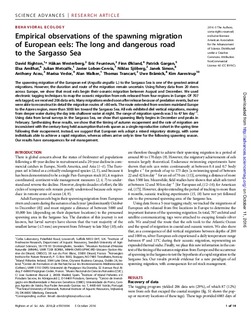Empirical observations of the spawning migrationof European eels: The long and dangerous roadto the Sargasso Sea
| dc.contributor.author | Righton, David | |
| dc.contributor.author | Westerberg, Håkan | |
| dc.contributor.author | Feunteun, Eric | |
| dc.contributor.author | Økland, Finn | |
| dc.contributor.author | Gargan, Patrick G. | |
| dc.contributor.author | Amilhat, Elsa | |
| dc.contributor.author | Metcalfe, Julian | |
| dc.contributor.author | Lobon-Cervia, Javier | |
| dc.contributor.author | Sjöberg, Niklas | |
| dc.contributor.author | Simon, Janek | |
| dc.contributor.author | Acou, Anthony | |
| dc.contributor.author | Vedor, Marisa | |
| dc.contributor.author | Walker, Alan | |
| dc.contributor.author | Trancart, Thomas | |
| dc.contributor.author | Brämick, Uwe | |
| dc.contributor.author | Aarestrup, Kim | |
| dc.coverage.spatial | Sargasso Sea, Atlantic ocean | nb_NO |
| dc.date.accessioned | 2016-10-11T11:15:54Z | |
| dc.date.accessioned | 2016-10-12T08:17:50Z | |
| dc.date.available | 2016-10-11T11:15:54Z | |
| dc.date.available | 2016-10-12T08:17:50Z | |
| dc.date.issued | 2016 | |
| dc.identifier.citation | Science Advances 2016, 2 | nb_NO |
| dc.identifier.issn | 2375-2548 | |
| dc.identifier.uri | http://hdl.handle.net/11250/2414417 | |
| dc.description.abstract | The spawning migration of the European eel (Anguilla anguilla L.) to the Sargasso Sea is one of the greatest animal migrations. However, the duration and route of the migration remain uncertain. Using fishery data from 20 rivers across Europe, we show that most eels begin their oceanic migration between August and December. We used electronic tagging techniques to map the oceanic migration from eels released from four regions in Europe. Of 707 eels tagged, we received 206 data sets.Manymigrations ended soon after release because of predation events, but we were able to reconstruct in detail the migration routes of >80 eels. The route extended from western mainland Europe to the Azores region, more than 5000 km toward the Sargasso Sea. All eels exhibited diel vertical migrations, moving from deeper water during the day into shallower water at night. The range ofmigration speeds was 3 to 47 kmday−1. Using data from larval surveys in the Sargasso Sea, we show that spawning likely begins in December and peaks in February. Synthesizing these results, we show that the timing of autumn escapement and the rate of migration are inconsistent with the century-long held assumption that eels spawn as a single reproductive cohort in the spring time following their escapement. Instead, we suggest that European eels adopt a mixed migratory strategy, with some individuals able to achieve a rapid migration, whereas others arrive only in time for the following spawning season. Our results have consequences for eel management. | nb_NO |
| dc.language.iso | eng | nb_NO |
| dc.rights | Navngivelse-Ikkekommersiell 3.0 Norge | * |
| dc.rights.uri | http://creativecommons.org/licenses/by-nc/3.0/no/ | * |
| dc.subject | eel | nb_NO |
| dc.subject | tagging | nb_NO |
| dc.subject | electronic tagging | nb_NO |
| dc.subject | oceanic migration | nb_NO |
| dc.subject | Sargasso Sea | nb_NO |
| dc.title | Empirical observations of the spawning migrationof European eels: The long and dangerous roadto the Sargasso Sea | nb_NO |
| dc.type | Journal article | nb_NO |
| dc.type | Peer reviewed | nb_NO |
| dc.date.updated | 2016-10-11T11:15:54Z | |
| dc.source.volume | 2 | nb_NO |
| dc.source.journal | Science Advances | nb_NO |
| dc.identifier.doi | 10.1126/sciadv.1501694 | |
| dc.identifier.cristin | 1390918 |
Tilhørende fil(er)
Denne innførselen finnes i følgende samling(er)
-
Publikasjoner fra CRIStin - NINA [2364]
-
Scientific publications [1392]
Vitenskapelige artikler, kapitler og monografier i Open Access.

